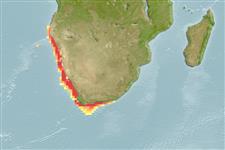>
Gobiiformes (Gobies) >
Gobiidae (Gobies) > Gobiinae
Etymology: Sufflogobius: Latin, sufflamen = clog + latin, gobius = gudgeon (Ref. 45335).
Environment: milieu / climate zone / depth range / distribution range
Ökologie
seewasser demersal; tiefenbereich 0 - 340 m (Ref. 27121). Subtropical; 11°C - 15°C (Ref. 27121); 16°S -
Eastern Atlantic: Namibia and South Africa.
Size / Gewicht / Alter
Maturity: Lm ? range ? - ? cm
Max length : 17.0 cm TL Männchen/unbestimmt; (Ref. 36731); max. veröff. Alter: 7 Jahre (Ref. 123628)
Rückenflossenstacheln (insgesamt): 7; Rückenflossenweichstrahlen (insgesamt): 12-13; Afterflossenstacheln 1; Afterflossenweichstrahlen: 12 - 13. Fins dusky to black in color (Ref. 2798). Presence of two name-bearing chin barbels (Ref. 92840).
Usually found offshore but was also recorded from shore pools (Ref. 5299). Found in shoals (Ref. 27121). Juveniles epipelagic, adults migrate to deeper waters, and large adults are only recorded from demersal trawls (Ref. 27121). Feeds on phytoplankton and preyed upon by fishes, penguins, Cape cormorants, and fur seals (Ref. 27121). Although targeted by purse seines, it may also be caught incidentally in trawls (Ref. 27121). Prefer cooler waters of 11° to 15°C (Ref. 36731).
Life cycle and mating behavior
Geschlechtsreife | Fortpflanzung | Ablaichen | Eier | Fecundity | Larven
Miller, P.J., 1990. Gobiidae. p. 925-951. In J.C. Quero, J.C. Hureau, C. Karrer, A. Post and L. Saldanha (eds.) Check-list of the fishes of the eastern tropical Atlantic (CLOFETA). JNICT, Lisbon, SEI, Paris; and UNESCO, Paris. Vol. 2. (Ref. 5299)
IUCN Rote Liste Status (Ref. 130435)
Bedrohung für Menschen
Harmless
Nutzung durch Menschen
Fischereien: weniger kommerziell
Mehr Information
ReferenzenAquakulturAquakultur ProfilZuchtlinienGenetikElectrophoresesVererbbarkeitKrankheitenVerarbeitungNutrientsMass conversion
Tools
Zusatzinformationen
Download XML
Internet Quellen
Estimates based on models
Preferred temperature (Ref.
123201): 10.3 - 16.4, mean 13 °C (based on 55 cells).
Phylogenetic diversity index (Ref.
82804): PD
50 = 1.0000 [Uniqueness, from 0.5 = low to 2.0 = high].
Bayesian length-weight: a=0.01023 (0.00477 - 0.02194), b=3.02 (2.84 - 3.20), in cm total length, based on LWR estimates for this (Sub)family-body shape (Ref.
93245).
Trophic level (Ref.
69278): 2.8 ±0.25 se; based on food items.
Generation time: 5.4 ( na - na) years. Estimated as median ln(3)/K based on 2
growth studies.
Widerstandsfähigkeit (Ref.
120179): mittel, Verdopplung der Population dauert 1,4 - 4,4 Jahre. (tm=4).
Fishing Vulnerability (Ref.
59153): Moderate vulnerability (38 of 100).
